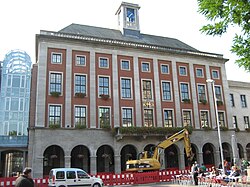Neuss
| Neuss | ||
|---|---|---|

Town hall
|
||
|
||
| Coordinates: 51°12′N 6°42′E / 51.200°N 6.700°ECoordinates: 51°12′N 6°42′E / 51.200°N 6.700°E | ||
| Country | Germany | |
| State | North Rhine-Westphalia | |
| Admin. region | Düsseldorf | |
| District | Rhein-Kreis Neuss | |
| Government | ||
| • Mayor | (SPD) | |
| Area | ||
| • Total | 99.48 km2 (38.41 sq mi) | |
| Population (2015-12-31) | ||
| • Total | 155,414 | |
| • Density | 1,600/km2 (4,000/sq mi) | |
| Time zone | CET/CEST (UTC+1/+2) | |
| Postal codes | 41460-41472 | |
| Dialling codes | 02131, 02137 (Norf), 02182 | |
| Vehicle registration | NE | |
| Website | www.neuss.de | |
| Largest groups of foreign residents | |
| Nationality | Population (2013) |
|---|---|
|
|
5,864 |
|
|
1,429 |
|
|
1,218 |
|
|
1,125 |
|
|
1,016 |
|
|
909 |
Neuss (German pronunciation: [ˈnɔʏs]; spelled Neuß until 1968; Limburgish: Nüss; Latin: Novaesium) is a city in North Rhine-Westphalia, Germany. It is located on the west bank of the Rhine opposing Düsseldorf. Neuss is the largest city within the Rhein-Kreis Neuss district. It is primarily known for its historic Roman sites, as well as the annual Neusser Bürger-Schützenfest. In 1984 Neuss celebrated 2000 years since its foundation. It therefore holds the title of "Germany's oldest city" alongside the city of Trier.
Neuss was founded by the Romans in 16 BC as a military fortification (castrum) with the current city to the north of the castrum, at the confluence of the rivers Rhine and Erft, with the name of Novaesium.
Legio XVI Gallica ("Gallic 16th Legion") of the Roman army was stationed here in 43-70 AD. It was disbanded after surrendering during the Batavian rebellion (AD 70).
Later a civil settlement was founded in the area of today's centre of the town during the 1st century AD. Novaesium, together with Trier (Augusta Treverorum), is one of the three oldest Roman settlements in Germany.
Neuss grew during the Middle Ages because of its prime location on several routes, by the crossing of the great Rhine valley, and with its harbour and ferry. During the 10th century, the remains of the martyr and tribune Saint Quirinus, not to be confused with the Roman god Quirinus, had been relocated to Neuss. This resulted in pilgrimage to the shrine of St. Quirinus even from countries beyond the borders of the Holy Roman Empire. Neuss was first documented as a town in 1138.
...
Wikipedia




